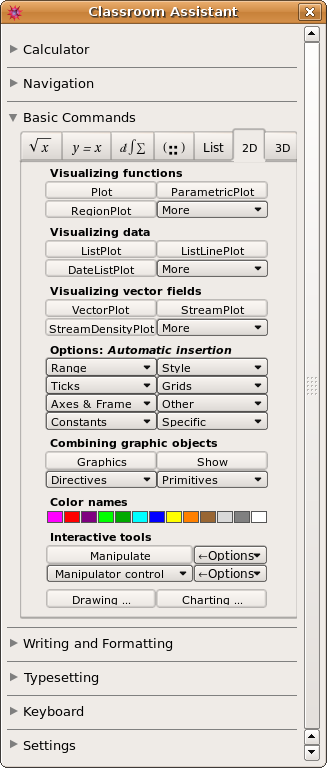Mathematica classroom assistant
When you start up Mathematica and get past the splash screen you are met with a blank screen and to a beginner* there are few things more terrifying than a blank screen. Imagine the scene…
“What can I do?” the beginner asks
“Anything you like,” replies the master “This package gives you the ability to explore all of mathematics. Calculus, Fourier transforms, special functions, number theory, image processing, linear algebra…all of these things and more are within your grasp. The world is your mollusc.”
“Um..Can it plot a graph? How do you plot the graph of sin(x) for example?” asks the beginner hopefully.
The master is somewhat deflated by this question. He has spent much of his life learning everything there is to know about Mathematica and wants to show off his knowledge. Hundreds of functions to choose from, hailing from every conceivable branch of Mathematics and the best this guy could do was the Sine function. Oh well…
“Sure – that’s easy” replies the Master “Let’s start out with a simple one. All you have to do is type the following”
Plot[Sin[x], {x, -Pi, Pi}, Ticks -> {{-Pi, -Pi/2, Pi/2, Pi}, {-1, 1}},
PlotStyle -> Red]
The beginner recoils in horror “But..but that’s PROGRAMMING. I’m not a programmer – I can’t do that kind of stuff. All I want to do is plot a graph. Can’t I just use Excel…?”
I have used Mathematica for a few years now (ever since 2000 if you’re counting) and so I can either remember or work out the syntax for commands like the one above with relative ease but I have taught enough beginners courses to know that the above scenario isn’t too far from the truth for many people. Learning Mathematica syntax can be a very daunting prospect if you have never done any programming before in your life.
Many students these days are much more used to clicking on buttons in a user interface to get a job done rather than typing in strings of commands. This is where the new classroom assistant comes in very useful.

The basic idea behind the classroom assistant is that you can look through the palette for what you want to do and when you click on the relevant button it will create a template for the command in a Mathematica notebook. For example, click on Plot and you get

All the user has to do now is fill in the blanks. What could be easier? For more detailed information concerning the Mathematica classroom assistant check out the recent Wolfram Research blog article written by Eric Schulz – the creator of this great new tool. If you would prefer a user’s perspective then take a look at the article written a while back by Maria of TCMTB.
*terrifying to more experienced people too for that matter
